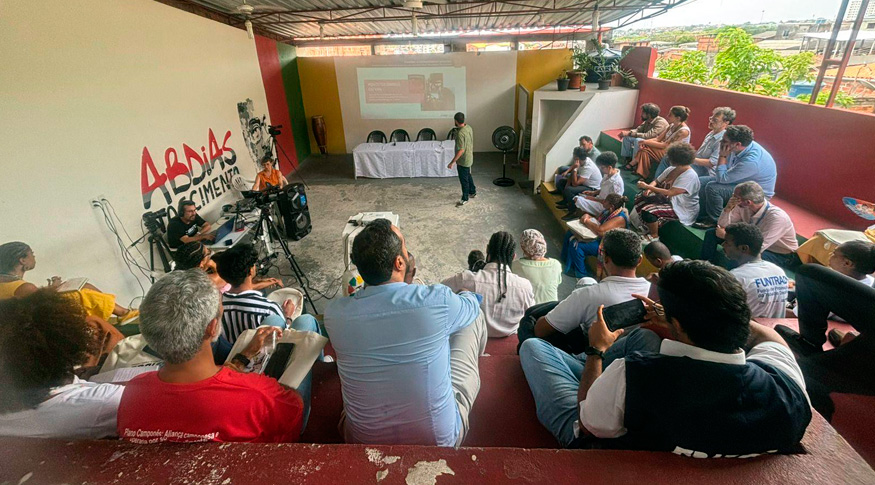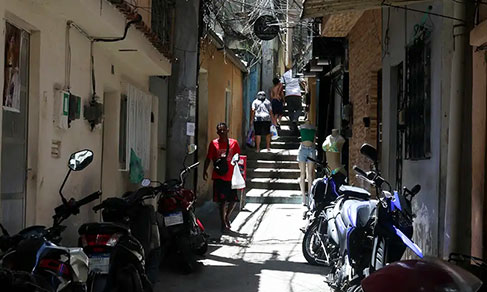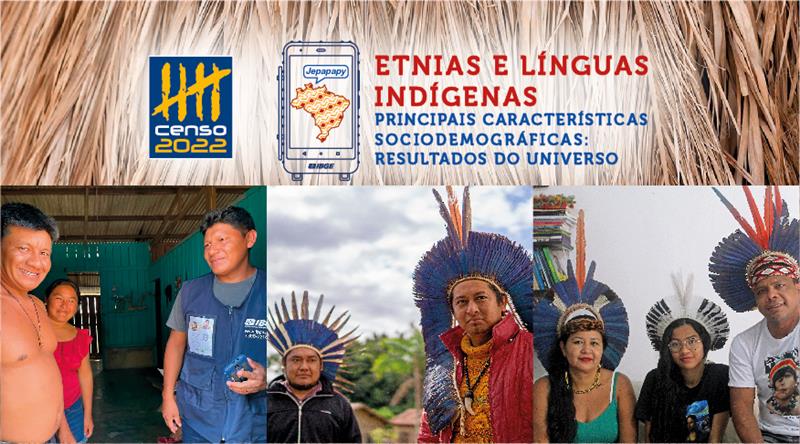Nossos serviços estão apresentando instabilidade no momento. Algumas informações podem não estar disponíveis.
Population Census
About - Preliminary Synopsis
It presents preliminary data from the 2000 Population Census, with information about the population in Brazil and in its metropolitan areas, including comparative tables showing previously-conducted censuses, as well as resident population and househing units, by Federation Units and municipalities.
Main results - Preliminary Synopsis
#tabelasidra201763151633383
The IBGE adopts a review policy of the data disclosed by this statistical operation. Data review means any and all scheduled revision of numerical data due to new information, which was not accessible at the time of the first disclosure. For instance: late data that replaces a non-response; or data corrected by the informant himself; or a set of data that has undergone editing and imputation. For more detailed information about the published data review policy of the IBGE statistical operations, check the list of short-term, long-term and special surveys carried out by the Institute with their respective revision procedure on: https://biblioteca.ibge.gov.br/index.php/biblioteca-catalogo?view=detalhes&id=298009.
Tables - Preliminary Synopsis
Tables
The IBGE adopts a review policy of the data disclosed by this statistical operation. Data review means any and all scheduled revision of numerical data due to new information, which was not accessible at the time of the first disclosure. For instance: late data that replaces a non-response; or data corrected by the informant himself; or a set of data that has undergone editing and imputation. For more detailed information about the published data review policy of the IBGE statistical operations, check the list of short-term, long-term and special surveys carried out by the Institute with their respective revision procedure on: https://biblioteca.ibge.gov.br/index.php/biblioteca-catalogo?view=detalhes&id=298009.
Publications - Preliminary Synopsis
Sinopse preliminar do censo demográfico : 2000
Material type: Journal
Year: 2000
Description
It is the major reference source to know the life conditions of the population in all the municipalities of Brazil and in their internal territorial divisions, having the resident person in the housing unit in the National Territory in the reference date as the data collection unit.
The Basic Questionnaire of the survey investigates information on the characteristics of the housing units (urban or rural status, number of bathrooms, existence of toilet, drainage of the bathroom or toilet, water supply, garbage disposal, existence of electricity, etc.); international emigration; composition of the housing units (number of residents, shared responsibility, list of residents, identification of the head, family relationship with the head of the household, etc.); characteristics of residents (sex and age, color or race, ethnicity and spoken language, in the case of Indians, ownership of birth registration, literacy, monthly earnings, etc.); and mortality. Selected housing units were investigated through the Sample Questionnaire, which includes more detailed items on the characteristics of the housing unit and residents in addition to those present in the Basic Questionnaire, as well as items on specific themes like disability, nuptiality and fertility.
The periodicity of the survey is decennial, except for the years of 1910 and 1930, in which the survey was canceled, and of 1990, whose operation was postponed to 1991.
The geographic coverage is nationwide, with results released for Brazil, Major Regions, Federation Units, Mesoregions, Microregions, Metropolitan Areas, Municipalities, Districts, Sub-districts and Enumeration Areas.
Historical Overview
The first population census in Brazil was carried out in 1808, specifically aiming at military interests of recruiting for the Armed Forces. It caused the suspect that its results would have been far from reality, due either to the natural prevention of the population against census operations or, mainly, to its objectives. For historical purposes, the census carried out in 1872, called General Census of the Empire, is considered the first one in Brazil, due to its bigger complexity and, above all, to the control exerted on the whole operation. It was established by Decree no. 4,856, of December 30, 1871, and conducted by the General Directorate of Statistics, later discontinued in 1879. The census scheduled for 1880 was transferred to 1887, eventually remaining just as a project. The General Directorate of Statistics was reestablished by Decree no. 113-d, of January 2, 1890, which set the date of December 31, 1890 to carry out the I Census of the Republic. The II Decennial Census of the Republic began on December 31, 1900 in the entire Brazilian territory. Nevertheless, problems with the calculation of the data in the city of Rio de Janeiro, then Federal District, caused the appointment of a commission to study this issue, which concluded to cancel the results related to the city. Based on a legal provision towards this aim, the Federal District carried out another survey just in 1906, completed in February 1907 and released in a special volume. Scheduled for December 31, 1910, the III Decennial Census of the Republic was transferred to June 30, 1911. The operation was definitively discontinued as a result of the political turmoil that Brazil was facing at the time. Carried out on September 1, 1920, the IV Decennial Census aimed at not only the population, yet also the economic situation of the localities. As a result, the industrial and agricultural production in Brazil were thoroughly investigated. Considering the decennial periodicity of the Brazilian censuses as established by law, the V General Census of Brazil should had taken place in 1930, yet a number of reasons, particularly those of political nature, hindered the operation that year. After the radical transformation of the statistical services in Brazil – creation of the National Council of Statistics - CNE and National Council of Geography - CNG, which, altogether, formed the IBGE, according to Decree-Law no. 218, of January 26, 1938 –, the V General Census of Brazil was carried out in 1940, corresponding to the fifth population census, second agricultural and industrial census, and first surveying on trade, transportation, communications and services. Carried out in 1950, the VI General Census of Brazil included the Population Census, whose reference date was fixed on July 1st, and the Agricultural, Industrial, Trade and Services Censuses, as well as the special surveys on transportation and communications. That census integrated the Census of the Americas, sponsored by the Inter-American Statistical Institute - IASI, addressing a specific request from the United Nations - UN. Held on September 1, 1960, the VII General Census of Brazil also followed the basic guidelines established by those international organizations, in order to assure the consistency of the concepts and allow the comparability of the census results among the American nations. In this survey, the sampling technique was used for the first time in a Brazilian census. Integrated with the Census of the Americas, the VIII General Census of Brazil was carried out on September 1, 1970, encompassing the Population Census and the Property, Agricultural, Industrial, Trade and Services Censuses, as well as special surveys on credit institutions, insurance companies and companies in charge of producing and distributing electricity. The IBGE carried out the IX General Census of Brazil on September 1, 1980, which included not only the Population Census, yet also the Agricultural, Industrial, Trade and Services Censuses and, after previous surveys, integrated with the Census of the Americas, as suggested by the UN. That survey counted on technological advances that allowed innovations in the operation and dissemination of results, which were published in the same year of the operation for the first time ever. Due to budget restrictions, the Population Census was not carried out in 1990, being postponed to September 1, 1991. Compared with the previous censuses, the 1991 Population Census innovated in a number of technical, technological and operational aspects, highlighting also the institution of partnerships – Municipal Census Commissions - CCMs and the Advisory Commission –, which worked as a link between the IBGE and the society. The 2000 Population Census, which resumed the operation in years ending in zero, anticipated the reference date of the survey from September 1st to August 1st, and represented a qualitative leap in a number of aspects, particularly concerning the technological innovation – from the system that followed up the data collection to the data capture and to the automation of the processes of data coding, edit and tabulation, through the extensive use of digital technologies, providing the most appropriate media to each segment of users. Its implementation consolidated the statistical bonds among the countries of the Extended Mercosur, which also includes Argentina, Paraguay, Uruguay, Bolivia and Chile. Carried out on August 1st, the 2010 Population Census made important transformations in the work methods, providing users with even more interactive and specialized pictures, characterized by relevant methodological improvements and technological advances. Partnerships were improved and strengthened through the State Census Commissions - CCEs and Municipal Commissions of Geography and Statistics - CMGEs, aiming at expanding the integration between the IBGE and the local communities to gather cooperation and logistics support for the implementation of institutional surveys.
Time series
#tabelasidra2018731246098
#seriehistorica20187312484678
#seriehistorica201873125221541
#seriehistorica20187312541828
...
Microdata
The microdata are the lowest level of disaggregation of the data of a survey, representing, in the form of numerical codes, the content of the questionnaires and preserving the statistical confidentiality aiming at the non-individualization of the information. The microdata are in ASCII format, allowing expert users with knowledge in programming, preferably in statistical software, to read the data, cross them in different geographic aggregations and create multiple tabulations according to their personal interest.
The microdata files are coupled with a support documentation that provides the names, codes and descriptions of the variables and their categories, complemented, whenever needed, with elements to compute the sampling errors.
2010 Census
Updating
March 11, 2016 - Variable v1005 - ENUMERATION AREA STATUS was included in the HOUSING UNIT, PERSON, EMIGRATION and MORTALITY files
Federation Units
Tables - Federation Units and Municipalities (in zip format)
- Rondônia
- Acre
- Amazonas
- Roraima
- Pará
- Amapá
- Tocantins
- Maranhão
- Piauí
- Ceará
- Rio Grande do Norte
- Paraíba
- Pernambuco
- Alagoas
- Sergipe
- Bahia
- Minas Gerais
- Espírito Santo
- Rio de Janeiro
- São Paulo - except MA
- São Paulo - MA
- Paraná
- Santa Catarina
- Rio Grande do Sul
- Mato Grosso do Sul
- Mato Grosso
- Goiás
- Federal District
- Microdata for the 14 municipalities with redesigned areas
- updated on March 31, 2016 - variable v1005 - ENUMERATION AREA STATUS was included in the Variable description files - Microdata of the sample of the 2010 Population Census - updated on March 15, 2016
- variable v1005 - ENUMERATION AREA STATUS was included in the Layout_microdados_Amostra_14_munic_20160301 file, in the sub-folders of HOUSING UNIT, PERSON, EMIGRATION and MORTALITY
2000 Census
Updating
September 8, 2017 - It was detected that variable V0300 was not in the housing unit file.
March 9, 2016 - It was detected that the activity and employment files were incomplete and that it was necessary to include new codes in the documentation that matches the codes of 2000 and 1991.
June 19, 2015 - It was detected that parts of some records were corrupted. The files were replaced.
Federation Units
Technical Information
Methodology of the survey carried out in 2010 (Methodological Reports Series, v. 41)
Methodology of the survey carried out in 2000 (Methodological Reports Series, v. 25)
Methodology of the survey carried out in 1980 (Methodological Reports Series, v. 4)
The changes that took place in the survey after the release of the methodological reports are presented either as Technical notes and/or Methodological notes. The technical notes either report or clarify specific issues on the survey, whereas the methodological notes address general aspects of the improvements, updates and/or revisions implemented, as well as complementary methodological aspects, whose clarifications have been made necessary before the release of a new formal volume of the Methodological Reports Series.
Technical notes
- Technical note 01/2018 - Reinterpretation of the data on disabled persons in the 2010 Population Census, in the light of the recommendations of the Washington Group
News and Releases
2022 Census
IBGE disseminates, in Salvador, the Census of the surroundings of housing units in Favelas and Poor Urban Communities
The IBGE released today (5) the data from the 2022 Population Census: Favelas and Poor Urban Community:...
05/12/2025
2022 Census
Nearly 20% of favela residents lived in streets without access for cars, buses and trucks
In 2022, Brazil had 19.2% of the population in favelas and urban communities living on roads accessible...
05/12/2025
2022 Census
More than 60% of residents in favelas and urban communities lived in treeless places
In the Brazilian favelas and urban communities, 64.6% of residents (10.4 million people) lived on stretches...
05/12/2025
2022 Census
In Salvador (BA), IBGE will release results of 2022 Census: Surroundings of Favelas and Urban Communities
The Brazilian Institute of Geography and Statistics (IBGE) will release, on December 5, at 10am, in Salvador...
26/11/2025
2022 Census
2022 Census: for the first time, less than half of the families in Brazil are composed of couples with children
Of the 72.3 million domestic units enumerated in 2022, 13.6 million (or 18.8%) were of the single person...
05/11/2025
2022 Census
2022 Census: consensual unions outnumber civil and religious marriages
In 2022, more than half (51.3%) of the population aged 10 and over in Brazil were living in a marital...
05/11/2025
2022 Census
In Aracaju (SE), IBGE will release results of the 2022 Census: Nuptiality and Family
Next Wednesday (5), the Brazilian Institute of Geography and Statistics (IBGE) will release the results...
31/10/2025
2022 Census
2022 Census: Brazil has 391 Indigenous ethnicities and 295 Indigenous languages
Data from the 2022 Population Census show the existence of 391 Indigenous ethnicities, peoples or groups...
24/10/2025
2022 Census
IBGE will release, in Campinas (SP), results of the 2022 Census: Indigenous Ethnicities and Languages
The Brazilian Institute of Geography and Statistics (IBGE) will release in São Paulo, on October...
16/10/2025
2022 Census
In Rio, IBGE releases 2022 census results for labor, earnings and commuting
The Brazilian Institute of Geography and Statistics (IBGE) released the preliminary results of the 2022...
09/10/2025
Errata
Replacement of publication 2022 Population Census: Nuptiality and Families: Preliminary Sample Results / IBGE
Published date: 12/11/2025
Description:
Flaws were found when processing the algorithm of identification of families, resulting in errors in the results produced for two municipalities - and hence for the aggregate results of the respective Federation Units, Major Region and for the national results of the Families theme.Actions: The complete publication has been replaced by a second edition amended and updated. The Sidra tables have been replaced as well.
Replacement of publication 2022 Population Census: Indigenous ethnicities and languages: Major sociodemographic characteristics: Population results
Published date: 25/10/2025
Description:
Amendment of four data in the first paragraph of page 223 of the complete publication. Instead of 99 languages, there are 97 languages for Manaus/AM; instead of 78, there are 77 languages for São Paulo/SP; instead of 61, there are 60 for Brasília/DF; and, instead of 68 languages, there are 36 for São Gabriel da Cachoeira/AM.Amendment of five data on pages 223 and 224 of the publication. On page 223, the value of 1 708 Municipalities was informed rather than 368 Municipalities; and of 389, rather than 19 Municipalities with 10 or more Indigenous languages spoken or used within Indigenous Lands. On page 224, 25 languages were informed, when the correct is 24 languages spoken in São Gabriel da Cachoeira/AM within Indigenous Lands. Values for Bom Jesus do Tocantins, in Pará, were also amended from 23 languages to 22 languages, and for Pacaraima, in Roraima, from 20 languages to 19 languages.
Actions: The complete publication has been replaced.
Replacement of vector files of product "2022 Statistical Grid"
Published date: 02/10/2025
Description:
It was noticed that the vector files of the 2022 Statistical Grid, in the 1km, 5km, 10km, 50km and 100km dimensions, did not contain cells without population and/or households, causing a spatial discontinuity. These vector files have been replaced by continuous versions, i.e., encompassing all the extension of the national territory.Actions: The files have been amended and replaced.
Replacement of files from the publication 2022 Population Census: Indigenous Localities
Published date: 19/09/2025
Description:
Inconsistencies were found in the formatting and content of the geospatial files for Indigenous Localities and Concentration Areas of Indigenous Peoples in the publication "2022 Population Census: Indigenous Localities," identified after its publication.Actions: All geospatial files for Brazil, including those for the states of Amazonas, Amapá, Tocantins, Alagoas, Santa Catarina, Rio Grande do Sul, and Mato Grosso do Sul, and those for the Federal District, were replaced.
Replacement of the SIDRA table from the 2022 Population Census - Religions - Preliminary Sample Results
Published date: 18/09/2025
Description:
The values in SIDRA table 10203 were calculated incorrectly.Actions: The table has been amended and replaced on the IBGE SIDRA platform.
Correction of files in the product Aggregated resuts by enumeration areas
Published date: 17/04/2025
Description:
Necessary corrections were made in the mesh of Enumeration Areas, causing the relocation of 18 housing units to a different enumeration area in the file “Agregados_por_setores_basico_BR.zip”. Variable V00003 had its name corrected from “Domicílios Coletivos Com Morador” to “Unidades de Habitação em Domicílios Coletivos Com Morador” in the file “Dicionário de dados”. Other 15 blank variables - V00236, V00243, V00250, V00257, V00280, V00281, V00282, V00283, V00284, V00303, V00304, V00556, V00563, V00570 and V00577 - were corrected in the files “Agregados_por_setores_caracteristicas_domicilios2.zip” and “Agregados_por_setores_caracteristicas_domicilios3.zip”.Actions: Replacement of files available for download on the release page an in the Methodological note no. 06/2024.
Replacement of publication Favelas and Urban Communities: population results / IBGE
Published date: 17/04/2025
Description:
Inconsistencies were found between the statistical and geographical databases of the 2022 Population Census, pinpointed during the final procedures of editing and checking of the statistical data aggregated by Enumeration Area. The population living in Favelas and Urban Communities changed from 16 390 815 to 16 390 790, whereas the total number of households changed from 6 556 998 to 6 556 968.Actions: The complete publication has been updated and replaced.
Replacement of publication Methodological notes no.07/2024: Sample expansion process for preliminary results
Published date: 30/01/2025
Description:
The amendment of the title of the methodological note referenced on page 11 of the publication was required.Actions: The publication has been replaced and the title of the methodological note, which talks about the construction of preliminary weighting areas, has been changed.
Correction of data in two graphs of the topic Indigenous peoples on the 2022 Census Overview website
Published date: 09/10/2024
Description:
The graphs "Population in indigenous lands" and "Indigenous lands by location of housing unit" of the 2022 Census Overview website presented incorrect data in the period between September 26 and October 04, 2024.Actions: The error was corrected on the 2022 Census Overview website in the afternoon of October 04.
Replacement of the publication 2022 Population Census: Indigenous Population: Literacy, birth records and characteristics of housing units, by specific areas: Population Results
Published date: 08/10/2024
Description:
Correction of two pieces of data in the last paragraph of page 42 of the complete publication. Instead of 24 municipalities, there are 25 where the proportion of the population living in housing units with a bathroom for exclusive use in 2022 was below 50% and, instead of 668 municipalities, there are 669 where this proportion was below 90%.
Five pieces of data on pages 164, 202, 218 and 219 of the publication were corrected. On page 164, the figure informed was 621 079 housing units, while the correct figure is 342 080 housing units. On page 202, the figure informed was 621 079 housing units, but the right figure is 516 176 housing units. On pages 218 and 219, percent changes were corrected from 9.42% to 9.39%; from 34.70% to 34.71%; and from 0.55% to 0.56%.Actions: The complete publication was replaced.
Replacement of 2022 Population Census: Characteristics of housing units: Population results publication
Published date: 05/06/2024
Description:
Amendment of two data in the last paragraph of page 42 of the complete publication. Instead of 24 municipalities, they are 25 in which the proportion of the population living in housing units with exclusive bathrooms in 2022 was lower than 50%, and, instead of 668 municipalities, they are 669 in which this proportion was lower than 90%.
Actions: The complete publication has been replaced.Error in release "Population and households - First results", specifically in results of municipalities Abel Figueiredo (PA) and São Pedro da Água Branca (MA)
Published date: 22/12/2023
Description:
Error in the data collection, pinpointed by the IBGE, in the inter-state border between Pará and Maranhão, in the municipalities of Abel Figueiredo (PA) and São Pedro da Água Branca (MA). The amendment caused the transference of a contingent of 894 persons and 330 households, being 265 occupied households with interviews from Abel Figueiredo (PA) to São Pedro da Água Branca (MA).Actions:
Tables SIDRA 4709, 4711, 4712 e 4714 of the "Population and Households -First Results" release with the amendments were made available on December 22, 2023.Observation:
The IBGE is producing a Technical Note, to be released soon, detailing this problem and showing all the actions aiming at its amendment.Error in release "Population by age and sex - Results of the universe", specifically in results of municipalities Abel Figueiredo (PA) and São Pedro da Água Branca (MA)
Published date: 22/12/2023
Description:
Error in the data collection, pinpointed by the IBGE, in the inter-state border between Pará and Maranhão, in the municipalities of Abel Figueiredo (PA) and São Pedro da Água Branca (MA). The amendment caused the transference of a contingent of 894 persons from Abel Figueiredo (PA) to São Pedro da Água Branca (MA).Actions:
Tables SIDRA 1209, 9514 e 9515 of the "Population by age and sex - Results of the Universe" release with the amendments were made available on December 22, 2023.Observation:
The IBGE is producing a Technical Note, to be released soon, detailing this problem and showing all the actions aiming at its amendment.Calendar error in the release of 2022 Population Census: Population by age and sex - Persons aged 60 years and over publication
Published date: 01/11/2023
Description:
Error, pinpointed by the IBGE, for not publishing the release date of the document titled "2022 Population Census: Population by age and sex - Persons aged 60 years and over" in the release calendar. The document was produced to complement the "2022 Population Census: Population by age and sex: Results of the universe" publication, released on October 27, 2023. Aware of the relevance of this theme, the text specifically deals with the population aged 60 years and over, which are the people considered Elderly persons according to the Statute of Elderly Persons.Actions: Release of a Highlight on the availability of the "2022 Population Census: Population by age and sex - Persons aged 60 years and over" document.
Calendar error in the release of the “2022 Population Census: Population by age and sex - Results of the universe” publication
Published date: 04/10/2023
Description:
Error, pinpointed by the IBGE, for not meeting the minimum 30-day anticipation to inform the public on the release date of the 2022 Population Census: Population by age and sex - Results of the universe publication, released on June 28, 2023. The release and updating will occur on October 27, 2023.Actions: The Highlight has been published on October 4, 2023.













